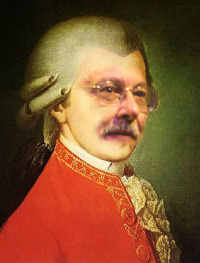A 365-Day Project
"We Are All Mozart"
A project to create
new works and change
the perception of the
music of our time.


 December 2, 2006
December 2, 2006 
Last night we had another huge rain -- almost two-and-a-half inches, which is a record for a single day's rainfall in central Vermont. The water was high, but we couldn't see it in the black of night -- only this morning was the damage visible. Our dock, already dislodged by the previous high water, was gone. So was a tree cut and blocked this summer, which was going to be hauled away as firewood by the person who cut it. The slate steps down to the water were turned into sculpture. We were gifted with two tires and a bathtub, and a ring of debris that reached most of the way across the horse paddock. And the water was roaring over the dam with a deep throbbing that we had never heard before. Certainly we'll be relieved when the never-completed dam is dismantled next August after eighty years as a slowly crumbling concrete barrier. The cold is now squeezing snow showers from the sky, as the temperature begins to fall -- fifty degrees in a week.
* * *
Many thresholds are discussed in music, such as the threshold of hearing and threshold of pain, and the threshold of intonation sensitivity. One that intrigues me is the threshold of rhythm. The transition point between pitch and rhythm has been explored, but I'm not sure about the outer limits -- threshold between rhythm and form, for example. Additive rhythm and expressive timing deal with issues just underneath this horizon, but don't address it directly. It's similar to the theshold of perception between waves and tides, between the second hand and the minute hand. In the latter of each example, we notice a change has taken place even if we cannot perceive the change in progress.
Another threshold is that between speech and music. As we have moved increasingly away from poetry as a meaningful genre for the public and for artists -- and I don't mean to start an argument, but this is a condition that even poets now appear to accept -- that threshold has become shallower. As electroacoustic composition has developed over a half-century, it too has shaved down the bump, with voices an intergral part of the rhythmic sensibility. There are two approaches to this: to let the voice lead, and to press the voice into service of a musical concept. Examples of the latter do not explore new rhythmic territory, such as Scott Johnson's John, Somebody (an otherwise astounding composition) and the later and better known piece using Johnson's technique, Steve Reich's Different Trains. In these works, both rhythm and pitch are incorporated and used as sonic sources for the instrumental writing. The pitches are slipped into standard progressions, and the rhythms are sliced and truncated to slide into familiar rhythmic modules.
The other side of speech in electroacoustics has let the voices provide a foundation for meaning, structure and temporal patterns that may or may not be considered rhythms. The foremost is likely Stockhausen's Gesang der Jünglinge with its meandering child song on "Preiset den Herrn," entirely stripped of its poetic rhythm and fragmented, and from it built imitative electronic sounds. The problem with Gesang and many speech-driven creations is the lack of a coherent or even discernable rhythmic vocabulary derived from the sources. On one side is Different Trains guiding vocal rhythm into tradition, on the other Gesang, guiding the composition toward vocal patterns. (In the middle somewhere are call-and-response work songs, which alternately compromise one to the other.)
The problem with the speech-rhythm threshold is meaning. In Sequenza for solo voice, Luciano Berio attempts to overcome this association, but fails by stripping meaning so thoroughly that the remainder is an artificial vocal landscape. Art is artificial, but that's not the point. Rather, words without meaning and without the rhythmic context of erstwhile meaning cannot serve as a speech-rhythm model. The solution to this perplexing question of associated meaning may be found in repetition; that is, a simple word repeated often enough does not lose its meaning so much as sound strange and unfamiliar. Take, for example, the words "milk carton." An image springs to mind immediately, but begin repeating the words slowly aloud and listen to how, while the meaning does not slip away, the words feel not quite right. "Milk carton" -- is that right? Milk carton. Carton. Milk carton. Carton ... carton feels -- odd.
This slippage of meaning (a phenomenon whose name I do not know) offers a way to find the speech-rhythm threshold, and create a rhythmic vocabulary based on the words themselves. Because of my intimate knowledge of it, I suggest The Moon, my composition for unaccompanied extended voice based on a poem of Geof Hewitt. A score and a recording are available. The personal, internal vocabulary is generated from the repetition in the score. The rhythm of the words is neither lost nor forced into a metrical arrangement, and the meaning remains intact (if occasionally ambiguous).
The problem with such a rhythmic vocabulary is replicating it for ensembles and developing a notational format that can be agreed upon by more than the single person it requires to perform The Moon. Notation for a contrapuntal composition using a rhythmic vocabulary of vocal extraction would necessarily abandon the simple divisions and tuplets of dot-music notation (even the nested and incomplete tuplets of the new complexity variety) and adopt a time-line approach or list of mathematical quantities -- either of which would, through its mechanics, simultaneously destroy associations with the origin of the vocabulary. (Oral tradition is a possibility that I have not explored, but which functions within, for example, the jazz idiom; John Coltrane's A Love Supreme is, in analysis by Lewis Porter and others, a spoken prayer played on the saxophone in speech rhythms.)
Much new nonpop does not accommodate biological presence, especially minimalism. It becomes bland. Why is it bland? Though influenced by African and Asian rhythmic repetition, essentially it is based in simple pop meters. Pop is song & dance; even jazz is rhythmically simple, except in the contours of its melody. The difference between dance [music] (where communal rhythm demands regularity) and composition (where individually conceived rhythm prevails) is significant. Even pop divides: the dance vs. the song. The former is a often a group effort done by some sort of band or ensemble with a metrical pulse keeping its individual members constrained; the latter is expressive, pushing and pulling rhythmic elements with a more biological sensibility. (When minimalism moved past its phase-shifting -- the rhythmic shift that was key to its distinctiveness -- it assumed the pop realm's conventions. The use of strict and simple rhythms may have been a welcome rebellion against serialism and its children, but now it is quite simply boring.)
What The Moon contains more than Jeff Buckley is a large quantity of biology, which brings me back to the first threshold, that between rhythm and form. Natural rhythms are cyclical and complex, and biological ones are cyclical and malleable. The precision of planetary motion, the seasons, the moon's cycles, the tides, and the rotation of the earth are all (above the quantum level) stable. Their relationship is not readily perceived, however, and their rhythmic character is so long that its larger scale is only perceived across generations (or with clockwork or computer models that speed them up as if we were looking out at the universe from a bobble). There's something here, but let me set it aside for now and consider performance issues.
Performers emote a great deal, and much of it is adjustment to the rhythmic shape -- the length and stress of the notes. A performer's interpretation is, in essence, an exercise in biological intervention into metrical rigidity. (In fact, the 'humanization' features in studio sequencers are statistical approximation of stress and duration adjustments to the raw sequenced information.) What if the rhythmic information built inside traditional meters contains temporal shifts and emphases that would deny interpretation? One of the earliest examples is Beethoven's Coriolanus overture. Instead of indicating a ritardando at the end, Beethoven asks for the opposite, a strict a tempo pulse -- and then changes the placement of notes in time through lengthening silences and creating duplets and triplets until the measures 'empty out' of sonic content and come to a slow and gentle halt, all while the conductor is still beating in strict time.
This exploration became a foundation of the precise temporal shifts in music by Elliott Carter (such as the metrical modulation in the third string quartet) and Ben Johnston (the proportional modulation in Knocking Piece). In the music of Carter and Johnston, however, metrical modulation is a feature of modernist or serial precision, not biology. From the perspective of the Twenty-First century, metrical modulation of the Carter type seems to serve a polemical purpose as much as an expressive purpose, in spite of the composer's intentions, because of the heavy serialist cloak the music wears. Even so, metrical modulation is far more akin to the behavior of bodies than unchanging metrical rigidity.
One question is how to access rhythm from an expressive point-of-view, i.e., biological and planetary perspectives. (This is not about to launch into Gaia-music, trust me.) The Beethoven or Carter models of rhythm are interesting, but actually propose nothing new. The rhythms are still metrically bounded and, at heart, simple. So now let's crib something from jazz: hot and cool. Analysis of the placement of elements with respect to the mechanical beat show some stresses slightly before or after it respectively; in other words, though still metrical, it simply adjusts the point of contact to effect a perception of performance style.
So far we have biological and planetary perspectives, rhythmic unbinding, and contact perception. That leaves some scientific elements with natural roots, another dip in the speech pool, and crossing the threshold of rhythm and form.
To be continued.

Slates steps reshaped as art by last night's floodwaters. They are the same steps, but their placement in space has been altered, their underpinning shifted, and their visual rhythm adjusted -- all without moving them out of order.